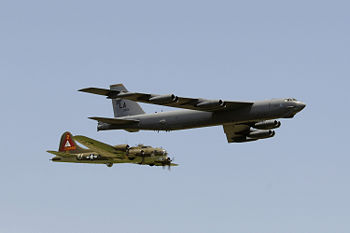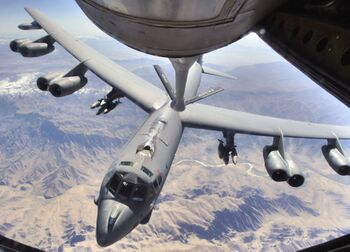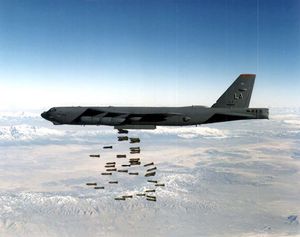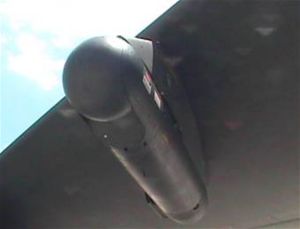B-52 Superfortress
A classic aircraft design still in service more than fifty years after the first version flew, the Boeing B-52 is a heavy bomber operated by the United States Air Force. The official "name" of Stratofortress has never been widely used; perhaps the most common name for it in the military is BUFF, an abbreviation for Big Ugly Fat Fellow[1]. The final model, B-52H, and the only one in service, is expected to stay in active service until at least 2040. [2] The B-52 celebrated its 50th anniversary (first flight April 1952) in April 2002 and is the longest serving combat aircraft in the world - a total of 744 were built.
Bombers had advanced rapidly in the Second World War, with the Boeing B-17 the mainstay of the offensive against Germany, and the B-29 against Japan. Both with the coming need to carry large nuclear weapons and have intercontinental range, requirements for a successor were being defined even during the war. While the B-36 was an interim attempt, it was a World War II design.
While the B-36 was approaching production, a new requirement was issued, in late 1945, for a bomber with an operational radius of at least 5,000mi/8,050 km, and greater speed than the B-52. [3] Initial Boeing proposals first were essentially a scaled-up B-29 with turboprops, first a straight-wing design and then a swept-wing turboprop reminiscent of the subsequent Soviet Tu-95 BEAR.
By 1947, these still did not appeal to the Air Force, and the XB-52 project, also being pressured by the Northrop XB-49, a "flying wing" reminiscent of the much later B-2 Spirit. It was made clear that the winning design would have to be pure turbojet.
Production begins
Eventually, Boeing was awarded a proposal in 1951, for 13 B-52A aircraft. An XB-52 and a YB-52 prototypes were already under construction. Only 3 A models were actually built, and served as test aircraft. The contract called for the aircraft to be convertible between a B-52 bomber and an RB-52 configuration. The B-52A first flew in 1954. A total of 744 B-52s were built with the last, a B-52H, delivered in October 1962.[4]
B, C, and D models: operational for high-altitude missions
The B model entered service in 1955. In 1956, a B-52 dropped a live Mark 15 thermonuclear bomb of 4MT yield over Bikini Atoll. The bomb detonated 30 seconds early, bending but not breaking the drop aircraft and other aircraft in the test. As Goebel put it, this "was fortunate as bailing out was not an option under the circumstances." [3] Other drops were done until the Atmospheric Test Ban Treaty went into effect in 1963.
In 1957, a flight of three B-52Bs, with air refueling, circumnavigated the planet in 45 hours and 19 minutes. Together with the demonstrated nuclear delivery capability, the force clearly demonstrated global reach in nuclear warfare.
B-52Cs and Ds had only minor modifications, the main changes being in the fuel system. The D model also dropped support of the reconnaissance pod; where the U.S. continued to specialize, the Soviet Union built even more Tu-95 and Tu-142 BEAR variants as maritime patrol/antisubmarine warfare, signals intelligence and maritime strike surveillance. In U.S. service, these missions went to transport aircraft derivatives such as the P-3 Orion and RC-135 RIVET JOINT.
E and F: low-altitude penetrators
Originally intended to fly high and fast to targets in the Soviet Union, improvements in the Soviet integrated air defense system made such a flight path suicidal, except when firing long-range air-to-surface missiles. In the nuclear delivery role, the aircraft was mechanically strengthened and given penetration flight paths at extremely low altitude. The next major modification was the E model, whose changes reflected the new tactic of low-level penetration of the Soviet Union, their high-altitude defenses having become too formidable. Soviet air defenses had improved to the point where high-altitude bombing was no longer practical, and so SAC switched to low-level tactics. This required new navigation and bombing avionics. The F model was essentially an E model with improved engines.
G: the longest production run
G models, of which 193 were built, had performance improvements including weight reductions while increasing fuel tank size.
Wing pylons were added for the AGM-28 Hound Dog cruise missile. Doctrine for this missile focused on using it as a penetration aid, to take out air defenses on the way to the targets to be attacked with gravity bombs.
At one point, the G was seen as the last model, with the B-52 to be replaced by the supersonic B-70 Valkyrie high-altitude bomber. Development problems, coupled with the serious question if high-altitude penetration was possible at any speed, resulted in the cancellation of the B-70 and commitment to the B-52H.
B-70 cancellation caused significant friction with the United Kingdom, since it led to cancellation of the associated Skybolt high-performance cruise missile program. The British had expected to use the Skybolt on their own strategic bombers.
H: Still in service
Only the H model is still in the Air Force inventory and is assigned to Air Combat Command and the Air Force Reserves.[4] The first of 102 B-52H's was delivered to Strategic Air Command in May 1961. The H model can carry up to 20 AGM-86 ALCM air launched cruise missiles. In addition, it can carry the conventional cruise missile that was launched in several contingencies during the 1990s, starting with Iraq and ending in the Balkans.
The B-52H entered service in 1961 and 104 were built. The last was delivered in 1962. However, due to extensive system and structural upgrades, its service life is expected to continue beyond the year 2040. Air refueling gives them worldwide range.
Historical operations
B-52 operations divide into three periods:
- Pure strategic nuclear delivery in the Cold War
- The force splits: some primarily used for tactical support in Vietnam, others remained on nuclear duty
- Present flexible force, primarily for support of ground troops and for missions with conventional weapons, but retaining a nuclear attack capability with cruise missiles. Strategic delivery of nuclear bombs would use the B-2 Spirit stealth aircraft, which can penetrate integrated air defense systems.
Cold War
Prior to 1957, the B-52 was available for worldwide strike, but needed considerable warning time. Partially driven by the coming of intercontinental ballistic missiles and submarine-launched ballistic missile that would give only minutes to launch, the Strategic Air Command put one-third of the force onto 15-minute alert, starting in October 1957. [3]
At this time, the standard weapon load was one or two "clips" containing either B28 (nuclear weapon)|B28 gravity bombs or dedicated penetration aids.
In the 1960s, the more powerful W41 (nuclear weapon)|B41 and W53 (nuclear weapon)|B53 bombs were added, as well as the 10 KT tactical B57 (nuclear weapon)|B57 bomb.
Also in the sixties, a number of steps were taken to shorten takeoff time, such as pyrotechnic engine starters (essentially large blank shotgun shells) rather than auxiliary power carts. The "minimum interval take off" (MITO) procedure, where a large force would take off, nose to tail like a herd of elephants, a collision always imminent in the dense smoke they produced.
In the Strategic Air Command, the alert system required 70-80 hour weeks on duty, with constant drills and draconian discipline. At any time, a senior general might fly in, without warning, and hold an Operational Readiness Exercise (ORE); that general could promote or demote on the spot, or even dismiss wing commanders. There was ever-present realization of what it would mean if the alert was ever real; the crews might survive, but their bases, homes, and families were apt to be radioactive dust.
Cuban Missile Crisis
The most intense airborne alert was during the Cuban Missile Crisis. The B-52 proved sufficiently reliable that the Air Force began to phase out B-47 medium jet bombers. B-47 range, even with air refueling. was shorter than that of the B-52, requiring politically sensitive forward bases outside the U.S. In addition, the smaller B-47 did not have the space to add the ever-increasing amount of electronic warfare systems. There had been some hope for the supersonic B-58 medium bomber, but that proved hard to fly and unreliable.
Still in the strategic role, the Single Integrated Operational Plan (SIOP) role of the B-52 evolved, given the increasing availability of missiles for fixed targets. In addition to the ability of manned bombers to strike mobile or contingency targets, they could send a deadly warning that missiles could not. If more bombers went onto airborne alert, as they did in the Cuban Missile Crisis, or flew closer to the Soviet Union, it was a threat that simply could not be transmitted by a missile crew moving their hands closer to the launch key.
Vietnam War
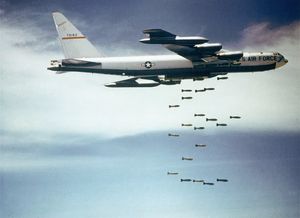
A U.S. Air Force Boeing B-52F-70-BW Stratofortress drops Mk 117 750 lb (340 kg) bombs over Vietnam, circa 1965-1966.
With the exception of the 11-day Operation Linebacker II attacks against North Vietnam in 1972, the B-52 bombers, designed for strategic nuclear attacks on Soviet and Chinese targets, principally operated in a tactical support role of mass bombing in South Vietnam. Other than the Linebacker campaign, the strategic bombing campaign against North Vietnam was carried out by Air Force and Navy fighter-bombers, designed as tactical aircraft.[5]
Under the code name of ARC LIGHT, B-52s flew missions over suspected enemy areas, each B-52 typically dropping 42,000 pounds of conventional explosives. They bombed from high altitude, out of sight and hearing, so the first warning of the actual attack would be exploding bombs. Poor U.S. communications security, as well as Soviet intelligence ships in international waters near the main base in Guam, would give a general warning that an attack was on the way, but not where.
While ARC LIGHT attacks were most common in South Vietnam, ground-controlled attack, precision for its time, began in July 1966. With the "combat sky spot" radar system, a ground controller could direct the bomber to release its payload over a specific spot designated by the supported troops.[6] This allowed their use against targets of opportunity discovered while they were en route, especially significant given that the enemy tended to know strikes were coming, and occasionally the general area.
This capability was used in close support at the Battle of Khe Sanh in 1967.[7] "Bugle Spot", a refinement of "Combat Skyspot", established pre-surveyed target boxes in the Khe Sanh area, where bombs could be dropped on call. The defenders found that the B-52 strikes had a major effect against North Vietnamese trenches and underground installations moving closer to the perimeter, with the bombs setting off sympathetic detonations of enemy ammunition.
Every three hours, six B-52s would arrive over Khe Sanh, to be directed to the target area judged most important at the time of arrival. By the end of the battle, 2,548 B-52 sorties had dropped 59,542 tons of bombs, turning the area around the base into something resembling the cratered surface of the Moon.
Gulf War
On what was to be the longest bombing mission in history, [8] B-52 bombers took off in the wee hours of the morning, for a 14.5 hour flight to the unmarked point in the sky, from which they would launch then-secret AGM-86C conventional air-launched cruise missiles, known by their crews as "Secret Squirrels", at targets in the Baghdad area. This strike was somewhat controversial, with critics claiming the Air Force flew a needlessly difficult mission to hit eight targets, including power plants at Mosul and a telephone exchange in Basra. In response, Air Force commanders pointed out that this long-range capability was available had a response been needed as soon as the Iraqis invaded Kuwait, when little else could have gotten quickly into position, yet not jeopardized crews flying into the teeth of the Gulf War, Iraqi integrated air defense system|Iraqi integrated air defense system (called KARI)]].
During the 1991 Gulf War, B-52s delivered 40 percent of the tonnage of all weapons dropped, [4] although it should be understood that much of this tonnage consisted of "dumb" gravity bombs used against troops in the open. On a number of occasions, such area bombing was not aimed to hit Iraqi soldiers, but as psychological warfare. [9] In contrast to the usual goal of achieving surprise in attack, the technique here, given that the Iraqi air defenses capable of hitting a B-52 were destroyed, was:
- On the day before the bombing, drop leaflets warning of the attack and giving instructions on how to surrender
- Bomb
- On the next day, drop more leaflets essentially saying "We kept our word. Save your lives."
Conventional and precision operations
Special operations teams in Afghanistan routinely directed B-52 attacks, on nearby targets, by providing target coordinates for Joint Direct Attack Munitions (JDAM). This was informally described as having a "2,000 pound hand grenade" available, quickly, to small forces.
With JDAM, it is possible for a B-52 to strike numerous independent tactical targets in the same mission. The GBU-39 Small Diameter Bomb equipped with JDAM is part of that evolution; one does not need or want a 2,000 pound bomb if a 250 pound bomb can hit very near the target.
Another enhancement was the addition of the AN/AAQ-28 LITENING electro-optical imagery and aiming pod.[10] This allows the B-52 not only to designate targets for precision-guided munitions, but to transmit imagery outside the aircraft. In addition to tactical cooperation, image transmission makes the B-52 more useful as a surveillance platform.
Nuclear operations
In practice, B-52's would deliver nuclear weapons only with the AGM-86. AGM-129 stealth cruise missiles are being retired, but not after an embarrassing incident when, in 2007, the Air Force lost track of six such missiles, with live nuclear warheads, being transferred from Minot to Barksdale for disassembly. Maj. Gen. Polly Peyer, who directed the Air Force internal review of the incident, said “We did see a diminished focus on the nuclear mission. You can kind of trace it back to 1991 and the end of the Cold War.”[11]
Flight systems
| System | Component |
|---|---|
| AN/ASQ-151 electro-optical viewing system (EVS) | AN/AAQ-6 Forward-looking infrared (FLIR) |
| AN/ASQ-151 electro-optical viewing system (EVS) | AN/AVQ-22 low-light television camera (LLTV) |
Communications include the UHF ARC-164|AN/ARC-164 SINCGARS and ARC-210|AN/ARC-210 SATCOM; ARC-190|AN/ARC-190 and ARC-310|AN/ARC-310 HF; FAB-T EHF SATCOM.
Offensive armament
Avionics
| System | Component | Function |
|---|---|---|
| AN/ASQ-176 Offensive Avionics System (OAS) | Northrop Grumman strategic radar | |
| AN/ASQ-176 Offensive Avionics System (OAS) | Honeywell radar altimeter | |
| AN/ASQ-176 Offensive Avionics System (OAS) | Smiths attitude heading and reference system | |
| AN/ASQ-176 Offensive Avionics System (OAS) | TERCOM terrain contour mapping | |
| AN/ASQ-176 Offensive Avionics System (OAS) | AN/ASN-131 | inertial navigation system (to be replaced with AN/SNU-84 |
| AN/ASQ-176 Offensive Avionics System (OAS) | AN/ASQ-38 | bombing and navigation system |
Weapons
Current B-52H aircraft carry all munitions in the internal bomb bay, although other models have variously carried air-to-surface missiles, decoys, or racks for additional conventional bombs on the wings.
The B-52H, with a weapons payload of more than 70,000lb, is capable of carrying the most diverse range of nuclear and non-nuclear weapons of any combat aircraft.
| Weapon | Type | Quantity | Comments |
|---|---|---|---|
| B83 (nuclear weapon) | gravity bomb with megaton-range yield | up to 8 | |
| B61 (nuclear weapon) | gravity bomb of moderate yield, | up to 8 | one version with limited subsurface penetration |
| AGM-86 ALCM | W80 warhead of 5/150KT yield | up to 20 | up to 1500mi/2400 km range |
The conventional weapons payload is some combination of four AGM-142 Raptor missiles, 20 AGM-86 ALCM|AGM-86 Air Launched Cruise Missiles (ALCM), 12 AGM-154 Joint Standoff Weapons (JSOW), 12 Joint Direct Attack Munitions (JDAM) and 16 Wind-Corrected Munitions Dispenser (WCMD). WCMD was first deployed by the B-52 in 2002 in Afghanistan. JSOW entered service in 2003 and was deployed during Operation Iraqi Freedom.
| Weapon | Type | Quantity | Comments |
|---|---|---|---|
| GBU-39 Small Diameter Bomb | Gravity bomb; can be guided | up to 32 | For minimum collateral damage |
| Mark 82 bomb | 500 pound high explosive | up to 51 | can be converted to JDAM |
| Mark 83 bomb | 1000 pound high explosive | up to 30 | can be converted to JDAM |
| Mark 84 bomb/JDAM | 2000 pound high explosive | up to 12 | usually configured as JDAM |
| AGM-84 Harpoon | anti-shipping missile | up to 8 | - |
| AGM-86 ALCM | Conventional air-launched cruise missile | up to 8 | 1200 km (750 miles) range; AGM-86C blast-fragmentation, AGM-86D hard target |
| AGM-154 Joint Standoff Weapon | Conventional air-launched cruise missile | up to 12 | 1200 km (750 miles) range |
| Wind Corrected Munitions Dispenser | gliding, guided cluster bomb | up to 16 | |
| AGM-142 Raptor | Electro-optically guided, man-in-the-loop precision attack | up to 3 plus guidance pod | Carried on pylons, at least 1 slot for guidance pod |
| Naval mine | up to 20 |
Defensive systems
While early B-52 aircraft were equipped with radar-controlled 20mm autocannon in the tail, all defensive equipment is now for electronic warfare, including defense against heat-seeking missiles.
| Designation | Description |
|---|---|
| AN/ALQ-172(V)2 | Radar detection and jamming |
| AN/ALR-20A | Radar detection and threat prioritization |
| AN/ALR-46 | Radar warning |
| AN/ALQ-155 | High power jammer |
| AN/ALQ-122 | Deceptive jammer |
| AN/ALR-155 | High power jammer |
| AN/ALQ-122 | Tail-mounted radar warning |
| AN/ALR-155 | High power jammer |
| AN/ALE-20 | Infrared flare decoy dispenser |
| AN/ALE-24 | chaff dispenser for radar reflectors |
The B-52 has used a variey of deceptive decoys. B-52s of the 1960s carried up to 8 ADM-20 Quail free-flying decoys in its bomb bay.
General characteristics
- Primary Function: Heavy bomber
- Contractor: Boeing Military Airplane Co.
- Power plant: Eight Pratt & Whitney engines TF33-P-3/103 turbofan
- Thrust: Each engine up to 17,000 pounds
- Wingspan: 185 feet (56.4 meters)
- Length: 159 feet, 4 inches (48.5 meters)
- Height: 40 feet, 8 inches (12.4 meters)
- Weight: Approximately 185,000 pounds (83,250 kilograms)
- Maximum Takeoff Weight: 488,000 pounds (219,600 kilograms)
- Fuel Capacity: 312,197 pounds
- Payload: 70,000 pounds (31,500 kilograms)
- Speed: 650 miles per hour (Mach 0.86)
- Range: 8,800 miles (7,652 nautical miles)
- Ceiling: 50,000 feet (15,151.5 meters)
- Armament: Approximately 70,000 pounds (31,500 kilograms) mixed ordnance -- bombs, mines and missiles. (Modified to carry air-launched cruise missiles)
- Crew: Five (aircraft commander, pilot, radar navigator, navigator and electronic warfare officer
- Unit Cost: $53.4 million (fiscal 98 constant dollars)
- Initial operating capability: April 1952
- Inventory: Active force, 85; ANG, 0; Reserve, 9
References
- ↑ "Fellow" is used with due regard to Citizendium's family-friendliness policy
- ↑ B-52H Stratofortress Long-Range Multi-Role Bomber, USA
- ↑ Jump up to: 3.0 3.1 3.2 Goebel, Greg, B-52 Evolution
- ↑ Jump up to: 4.0 4.1 4.2 Air Force Link, B-52 Stratofortress
- ↑ Goebel, Greg, B-52 in Southeast Asia: ARC LIGHT
- ↑ Globalsecurity.org, B-52 Stratofortress History
- ↑ Boyne, Walter J. (August 1998), "Airpower at Khe Sanh: The North Vietnamese thought it was Dien Bien Phu all over again. They thought wrong.", Air Force Magazine 81 (8)
- ↑ Tirpak, John (April 1994), "The Secret Squirrels", Air Force Magazine 77 (4)
- ↑ Schwarzkopf, H Norman, Jr. (1992), It Doesn't Take a Hero, Bantam
- ↑ "Upgraded B-52 still on cutting edge", Air Combat Command, 31 March 2008
- ↑ Michael Hoffman (26 February 2008), "Nuclear safety slipped for years before Minot", Air Force Times
